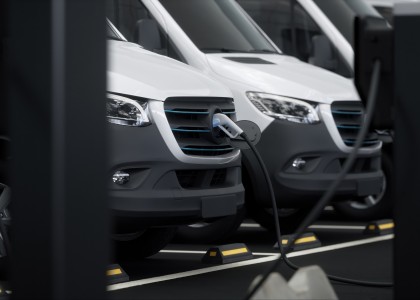States up efficiency investments & power savings; push net-zero buildings & electric vehicles; NJ, CT, CO, SD improve most; MA and CA lead
Washington, DC— As the US government loosens environmental rules, states are investing more in energy efficiency and delivering increased power savings, according to the 2018 State Energy Efficiency Scorecard. This 12th annual report from the American Council for an Energy-Efficient Economy (ACEEE), released today, identifies the leaders (Massachusetts and California), the most-improved states, notably New Jersey, the states that lost ground such as Iowa, and those lagging behind, including North Dakota, West Virginia, and Wyoming.
The scorecard offers mostly good news about energy efficiency — the nation’s third-largest electricity resource. In response to federal efforts to freeze US vehicle and appliance standards, quite a few states worked to retain their own standards and to promote electric vehicles as well as zero-energy buildings. While some, like Iowa and Connecticut, saw legislative attacks within their states, others — including Virginia, New York, New Jersey, Colorado, and Arkansas — unveiled plans to boost investments in efficiency and clean energy, often driven by concerns about climate change.
The scorecard, which ranks states based on 32 metrics in six areas, has these key findings:
- New Jersey improved the most, moving up five ranks to #18. The Garden State set new annual energy savings targets and took steps to rejoin the Regional Greenhouse Gas Initiative, a multistate cap and trade emissions compact. Missouri, Connecticut, Colorado, and South Dakota showed marked improvement. Other improved states include Nevada and North Carolina.
- Massachusetts continued to rank #1 overall. It launched a plan to set new three-year energy savings targets and approved utility spending for grid-scale modernization. A close second is California, which led efficiency efforts in three areas: buildings, transportation, and appliances. These leaders are followed by Rhode Island, Vermont, Connecticut, New York, Oregon, Minnesota, Washington, and Maryland.
- Iowa fell the most, moving down five spots to #24. This drop was due mostly to a bill signed earlier this year (SF2311) that imposes a restrictive cap on efficiency programs and allows customers to opt out of paying for some of them. Sixteen other states also fell in the rankings.
States increased investments in energy efficiency in the utility sector. They spent nearly $8.0 billion last year, up from $7.6 billion in 2016. The result was a 7.3% increase in electricity savings (nearly 26.5 million megawatt-hours) — enough to power about 2.5 million US homes per year.
- States ramped up efforts to promote zero-emission vehicles (ZEV), mostly electric, as the federal government sought to freeze fuel economy standards for cars and SUVs. California joined with eight other states in rolling out an updated ZEV plan, which incentivizes consumers to buy ZEVs. Missouri moved to incentivize the rollout of more EV charging stations, and Oregon to require new buildings be ready to charge EVs.
- More states pushed for zero-energy construction (buildings that produce as much power as they use) largely through tougher building codes. California calls for all new homes and commercial buildings to be net zero-energy by 2020 and 2030, respectively. Vermont, Rhode Island, Oregon, Washington, the District of Columbia and Massachusetts have incorporated net zero-energy construction into long-range plans.
“States are stepping up on energy efficiency, including major new commitments in New Jersey, New York, and Virginia, helping to address the very limited activity from Washington, DC,” noted ACEEE Executive Director Steve Nadel. “These efforts contributed to the 2.25 million-plus efficiency jobs last year in the United States.”
Massachusetts' Governor Charlie Baker said: "We are proud Massachusetts leads the nation in energy efficiency for the eighth year in a row, and we will continue to adopt and pursue measures that deliver billions of dollars in savings to our residents and businesses each year. Massachusetts remains committed to leveraging energy efficiency and clean energy to meet climate goals, reduce costs and grow the Commonwealth’s economy.”
New Jersey’s Governor Phil Murphy said: “The fact that New Jersey has emerged as the most-improved state speaks volumes on the state’s commitment to becoming a 100 percent clean energy state by 2050. We’ve made enormous progress in very short order, but there remains more hard work ahead. I look forward to New Jersey’s continued leadership on making our environment healthier, cleaner, and more sustainable for future generations.”
California Energy Commissioner Andrew McAllister said: “Modern energy efficiency facilitates renewables integration and reduces the scale of investment required for our ongoing, rapid transition to reliable, emissions-free energy systems - thus boosting our economy and protecting the health of all Californians.”
Rhode Island’s Governor Gina Raimondo said: “I am proud that Rhode Island continues to be a national leader in energy efficiency. Every day, we’re continuing to make our energy supply cleaner, more affordable, and more reliable. These programs have saved businesses and families more than $200 million in the past three years alone, while at the same time helping us fight climate change and creating thousands of new clean energy jobs.”
Weston Berg, lead author, discusses Scorecard findings.
- States ramped up efforts to create the utility of the future. Ohio, Rhode Island, New York, California, and Minnesota have major plans in place. They’re looking to modernize grid infrastructure, leverage data, and deploy more distributed energy resources.
- California and Vermont led in setting appliance standards. California, which has standards for 100-plus products, set new standards for computers, computer monitors, and portable electric spas in 2017. This year Vermont adopted new standards for 16 products.
- States focused on innovative financing solutions. Six states (California, New York, Connecticut, Hawaii, Nevada, and Rhode Island) have set up green banks, and Washington, DC, passed legislation this year to do the same.
The scorecard assesses state policies and programs in six areas: utilities, buildings, transportation, state government, combined heat and power, and appliance standards. It highlights best practices for promoting energy efficiency, typically the lowest-cost way to meet customers’ energy needs. Such efficiency improves air and water quality, strengthens grid resilience, promotes equity, and improves health and comfort.
MEDIA CONTACT: Patrick Mitchell, (703) 276-3266 or pmitchell@hastingsgroup.com.
EDITOR’S NOTE: An electronic copy of the ACEEE 2018 State Energy Efficiency Scorecard report and a high-resolution image of the ACEEE logo will be available upon request. A replay of the webinar that announced the findings will be available at [link] as of 5 pm EDT on Thursday, October 4, 2018.
The American Council for an Energy-Efficient Economy acts as a catalyst to advance energy efficiency policies, programs, technologies, investments, and behaviors.




